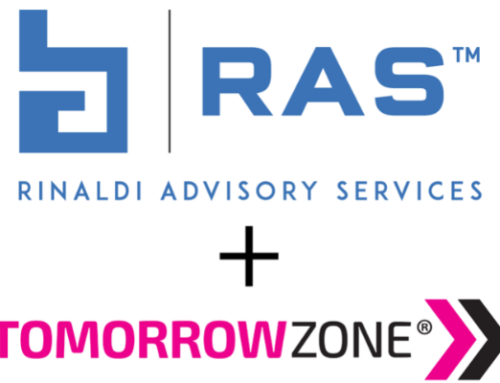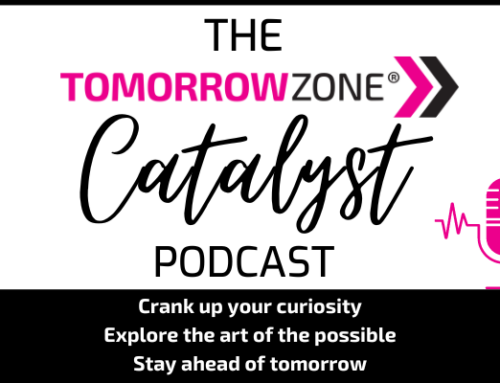
This article was originally published by MonitorDaily in February 2024.
Reprinted with permission from the author.
Surprisingly, a McKinsey study on what holds back innovation revealed 85% of executives interviewed, said fear often or always holds back innovation efforts.[1] It may sound mind blowing, but 90% of them are doing nothing to allay these fears. Whether for a company, industry or even on a personal level, how might we embrace curiosity, learn forward and overcome the fears that hold back transformative change?
I sat down with Chris Cummins, a seasoned professional speaker, to dive into his journey from surgical equipment sales to keynote speaking, large scale virtual event production and coaching leaders on presentation skills. We explored how curiosity, experimentation and continuous learning can accelerate growth and even lead to an entirely new business model.
Deborah Reuben: Could you briefly share your background and the journey that led to what you do today?
Chris Cummins: For nearly two decades, I’ve been a professional speaker, but my journey began in the challenging world of surgical device sales. I was selling $20,000 to quarter million-dollar gizmos to neurosurgeons. Through this experience, I discovered that rather than selling, I thrived in and found most fulfilling, educating and engaging surgeons through presentations and training sessions.
Encouraged by friends who saw my potential, I shifted gears to focus on what I enjoyed most — speaking and teaching. This transition led me to keynote speaking at major conferences and, over time, I’ve transitioned my expertise to now guide others in mastering the art of effective communication and presentation.
Reuben: How are you helping leaders level up presenting and speaking?
Cummins: For years, people would come up to me after keynotes and say, “Wow the way you engaged 1,000 people, you could hear a pin drop in that room. Will you teach me to do that?”
Showing up well on stage or on camera is not something people are born with. It can be taught. Everybody can become a much more effective presenter if they’re open to the incredible discomfort of getting on a stage.
To help leaders master presenting, we break it down into granular elements. This includes the art of storytelling, tone, voice inflection, body language and stage presence.
So many people fear public speaking. My approach is to refine not only their messaging but also their delivery, whether they’re on stage or on camera. It’s about transforming the nervous energy into a captivating presence that can command the attention of an audience, no matter the size. My goal is to turn effective communication into a learned skill for any leader.
Reuben: Many people fear public speaking. How do you push leaders beyond comfort zones on stage?
Cummins: By using authenticity and shared experience. I regularly speak to very large audiences of thousands, both in-person and virtually. Your brain chemistry changes when you know there are a lot of eyeballs on you. You get into fight or flight mode. The physiological response to being observed — nervousness — is universal.
I get real and show executives videos of my speeches to demonstrate that despite appearing calm, I still experience nerves, just as they might. If you’re waiting for those nerves to disappear, I got news for you, my friend, they don’t.
The key is not to wait for fear to subside or push it away. Embrace it. Dance with it. You eventually calm down enough on stage so you can be more real. You channel nervous energy into authentic and confident stage presence.
It’s not just about the words you use and what order, it’s about what’s going on in your brain. So, we work on what I call the first nine steps. A tight opener. So well-crafted chaos could erupt around you, but you are dialed in giving the first three minutes of content. You know where to look, how to move, what to do with your hands. We get you to own the room for the first few minutes while your brain is in the crazy fight or flight panic mode.
It’s not merely about the script but the mental preparation. Overcoming what’s happening in your brain. I train leaders to perfect their opening remarks, to the point where, despite any surrounding chaos, their delivery is flawless and engaging. Mastering the first three minutes gets you past the flight-or-flight response, so you move into a stage of calm confidence for the rest of your presentation.
In my work, starting off strong is crucial for setting a confident tone. Clients often remark on my calm demeanor during keynotes, highlighting the seamless transition from casual conversation to presentation. This authentic presence on stage is developed through practice and a mindset shift from speaking at people to conversing with them, as if with friends. I learned early on that an over-performed, high-energy start could exhaust both myself and the audience. Now, I focus on genuine engagement from the very beginning, embodying the same person onstage as offstage, which in turn, resonates well with the audience and sets the stage for a successful presentation.
Mastering Authentic Stage Presence
Cummins: “Whether a thousand people or a boardroom of eight or nine people, your presentation starts, my friend, long before it starts.” It’s about the comprehensive preparation that begins with the very first interaction, from emails to meetings before the event. It’s in the details: your posture, your expressions, where you stand, how you breathe. All these elements contribute to seeming ‘cool as a cucumber’ to your audience.
When you’re internally panicking, you must project calmness to keep the audience from feeling anxious on your behalf. Manage your own anxiety through deliberate practices like breathing exercises and pre-stage routines. Your presentation begins with the audience’s perception of you, which can be established well before you speak your first word.
Embracing the discomfort of growth—is essential for developing resilience for public speaking. No matter how much experience you have, it’s natural to feel nervous. That’s not a signal to retreat to comfort, but to lean into the challenge and grow.
Reuben: How are you personally leaning into curiosity and learning forward?
Cummins: I’m deeply motivated by continuous self-improvement and the pursuit of knowledge. I get great joy stretching my brain into areas that it’s never been before and forcing it to learn a thing that is wildly foreign. This compels me to constantly seek new experiences and expand my understanding.
Currently, I’m channeling my curiosity into language learning, specifically greeting and thanking people in as many languages as possible. It stretches my mental capacities and enriches my interactions with people from diverse backgrounds. The joy of learning, thrill of adding new concepts and words to my vocabulary and pleasure of engaging with different cultures drives me to stay in the growth zone.
Reuben: Would you share examples of your process for experimenting and learning new things?
Cummins: When the pandemic halted in-person events, disrupting my keynote speaking business, I had to pivot to virtual platforms quickly. I was showing up to Zoom meetings with a laptop and crummy mic. At first, I struggled with poor audio quality and unflattering camera angles. Seeing the recording of my first Zoom presentation, frankly, was embarrassing on every level. Terrible audio quality. With the camera below me, I looked 900 pounds. My lighting made me look like I was dying.
I got curious about how to show up better. Researching. Experimenting. Embracing Jim Rohn’s advice that “success leaves clues,” I studied and deconstructed what successful speakers were doing to show up well virtually. Invested in creating a professional home studio setup, focusing on lighting, sound and camera work.
It paid off. I mastered showing up well on video and presenting effectively at virtual conferences. People asked, “Can you please produce our virtual conference?” Cummins media launched a new division producing large scale virtual events for clients. A graduation ceremony for 20,000. A large-scale investor road show featuring a live virtual gold mind tour. This is way beyond keynotes. Now I have a virtual event production team. Sometimes I speak at them. Sometimes I emcee them. Sometimes I sit back, and my team does it all. It’s an enormous switch from solopreneur speaking guy of 15 years ago.
Now I’m pursuing earning my helicopter license, a lifelong dream. Every time I am in the air, the mental focus and physical coordination stretches me. Sometimes my instructor must remind me to breathe. New brain connections happen. It’s so refreshing. I sleep like a baby after lessons.
Reuben: What can leaders do today to shape a better tomorrow?
Cummins: Embrace new experiences and confront intellectual fears. Follow your curiosity. For instance, I got a drone pilot license for giggles. It got me wondering what’s possible for getting a helicopter pilot license. I got here; maybe I can get there.
Try this exercise: write down three things you’re nervous about that you’d like to do one day but you’ve been putting them off. Circle one of them to just take a baby step toward it. That wasn’t so hard. What if you take another step?
It isn’t about immediate success; it’s about progression — overcoming inertia and fear. Each small step can lead to surprising discoveries and connections with others who share similar goals, and continuous growth
Chris Cummins is a seven-time TEDx speaker, author, inspiring keynote speaker, TV host of upcoming “Charged-Up Show.” Leading Cummins Media for 19 years, his clients and audiences include BMW, FED-EX, Microsoft, Manulife Bank, Olympic Committee leadership team, Alamos Gold Mines, BNY Mellon and more. He works with CEOs and leaders to improve their on-stage effectiveness. Learn more at ChrisCummins.com.
[1] Furstenthal, Morris, and Roth, “Fear Factor: Overcoming Human Barriers to Innovation,” McKinsey. June 3, 2022.





